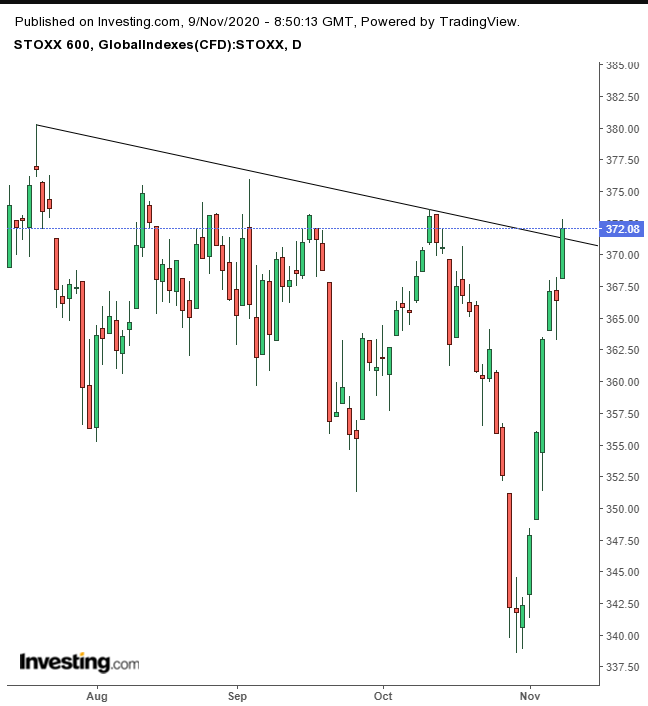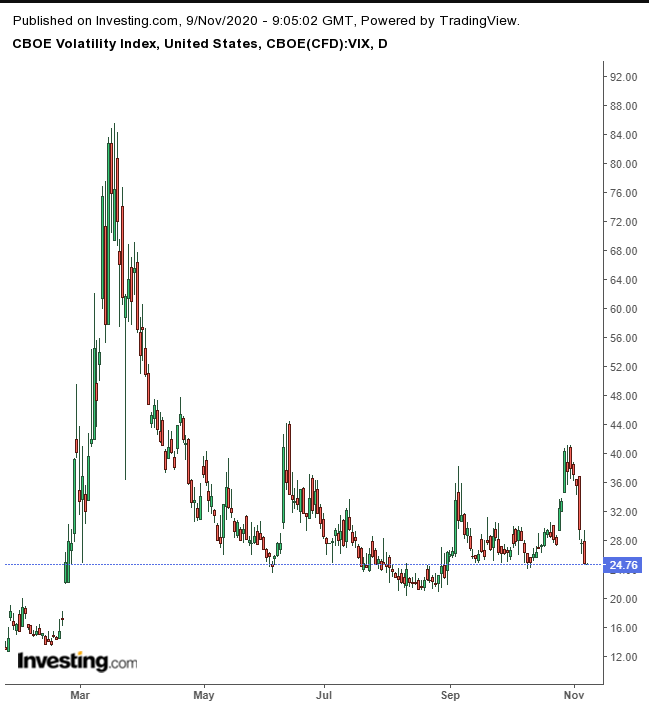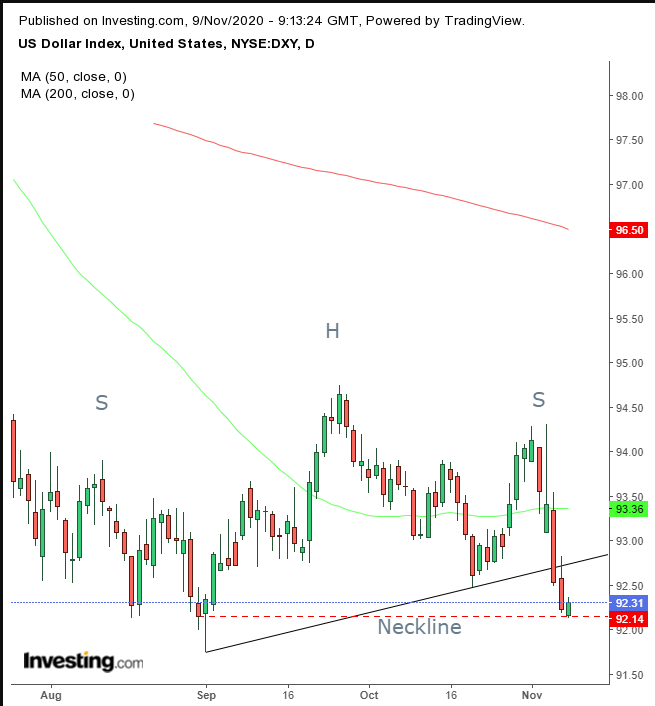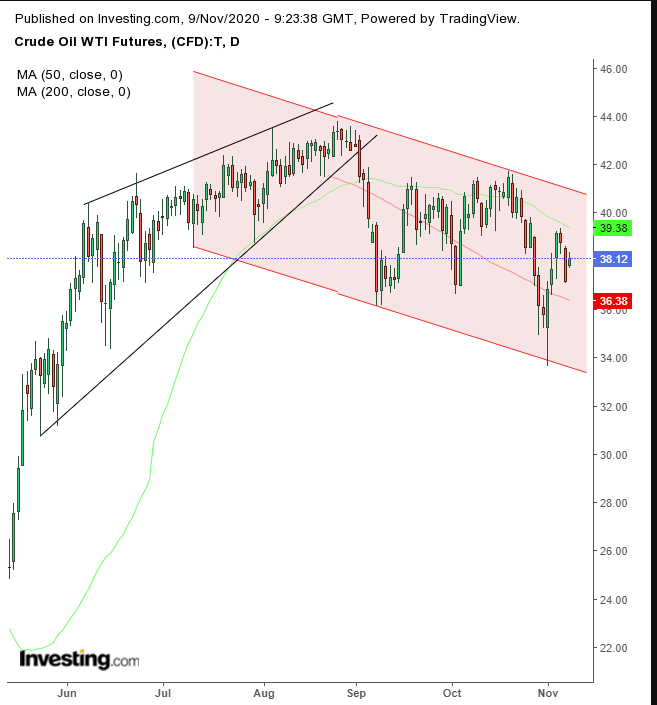- Biden promises unity but a divided US Congress, unable to agree on stimulus is expected to force the Fed to increase QE
- Gold climbed despite a strong dollar and rising stocks
Key Events
US futures, including for the Dow, S&P, NASDAQ and Russell 2000 point to a jump on Wall Street when markets open on Monday. European markets are all trading in the green on positive momentum following Joseph R. Biden's US presidential election win.
Treasury yields fell and oil rebounded despite concerns that increased coronavirus cases in the US and Europe will delay an economic recovery.
Global Financial Affairs
Last week, markets rallied on speculation of a Blue Wave in the US elections that would pave the way for a massive coronavirus stimulus package. However, as the counting began, the focus shifted to the new reality. Investors are betting that the Democratic president-elect not control over the Senate, leaving him stuck with administrative gridlock, and all of President Donald Trump’s tax cuts and deregulations.
However, now the market narrative is that Biden’s inability to launch a massive fiscal aid package will force the US Federal Reserve to continue pumping cheap money into the economy while keeping rates historically low, which would continue to drive stock prices higher.
When the bulls are charging any excuse will do, even if it conflicts with previous narratives.
We've seen this before. Ahead of the 2016 presidential election, stocks were rallying on the expectation of a win by Democratic nominee Hilary Clinton, and an unlikely win by Republican Donald Trump was expected to see markets tank.
However, after the unbelievable happened and Trump, against all the odds, won, markets sold off for a mere 3 hours afterward, but then reversed sharply and continued climbing.
The 2016 narrative flipped from Trump being a disaster for markets, because of his protectionist rhetoric, to his being a staunch enabler, because of his pro-business approach to tax cuts and deregulation—all of which was well known beforehand.
Over the weekend, US cases of COVID-19 hit 10 million as the country reported more than 100,000 new infections for a fourth consecutive day. Cold weather compounded by holiday gatherings is expected to add fuel to the already out of control viral fire.
Despite this, S&P 500 futures notched a 1.5% advance this morning, adding to last week’s 7.3% gain, the strongest up-move since April. Contracts on the tech-heavy NASDAQ 100 index, which have outperformed since Tuesday’s vote, were also up more than 2%.
In Europe, the Stoxx 600 opened 0.5% higher and shot up to a 1.5% gain.

The pan-European index is taking on the downtrend line, in place since its July 21 high.
Asia was deep in the green earlier, with Japan’s Nikkei the greenest, (+2.1%), as it soared to a 29-year high.
On Friday, mild profit-taking after a four-day rally made last week the biggest week for stocks since April, as $1.5 trillion in value was added to markets.
The VIX is down for the sixth day.

The volatility index reached its lowest since Aug. 26 but is still well above pre-pandemic levels.
Yields, including for the 10-year, fell towards 0.8% again, demonstrating demand for haven Treasuries despite the overall risk-on appetite, which jibes with speculation of continued QE and longer low rates.

Technically, rates are in a clear uptrend within well defined boarders for supply and demand, in a rising channel, supported by a Golden Cross.
The dollar found support at the Sept. 1 hammer.

Bargain hunters bid up the greenback, which last week had reached a 10-week low. That's contrary to the market narrative that the USD will lose value with continued QE and ongoing low rates. Perhaps foreign demand for Treasuries provided a fundamental boost to the dollar, as well as its technicals.
Incredibly, gold climbed for the third day, even though both stocks and futures were higher, dispelling the accepted thesis that gold rises only on its safe haven status. Equally contrary right now is the idea that a stronger dollar generally weighs on the price of the precious metal. As such, technicals could be the only reason for the yellow metal's current strength.

It appears the real reason gold is up is momentum, following a bullish wedge. The precious metal's trajectory could remain bullish into next year.
Bitcoin is struggling and was little changed, even after Wall Street Legend Bill Miller strongly recommended the cryptocurrency.
Oil rebounded from a two-day selloff, as it continues to trade within the 50 and 200 DMA after those triggered a Death Cross in the beginning of the month.

Overall, the price has been traded within a falling channel, following a bearish wedge.
Up Ahead
- On Monday, Brexit trade-deal talks between the U.K. and EU continue in London, with several tricky sticking points remaining.
- Tuesday is the EU’s target date for triggering tariffs on as much as $4 billion of US goods in retaliation for illegal aid to Boeing (NYSE:BA).
- Alibaba (NYSE:BABA) holds its annual Singles’ Day on Wednesday, an online global shopping phenomenon that clocked $38 billion of sales last year.
- ECB President Christine Lagarde, BOE Governor Andrew Bailey and Fed Chair Jerome Powell are among the speakers at an online ECB Forum entitled “Central Banks in a Shifting World” on Thursday.
- The US reports CPI and initial jobless claims on Thursday.
- Finance ministers and central bankers from the Group of 20 hold a virtual meeting Friday to finalize a framework for poor nations to address their debt problems, ahead of the annual G20 summit Nov. 20-21
Market Moves
Stocks
- Futures on the S&P 500 index increased 1.2%.
- The Stoxx Europe 600 index climbed 1.5%.
- The MSCI Asia Pacific index rose 0.78%.
- The MSCI Emerging Markets index gained 0.87%.
Currencies
- The Dollar Index decreased 0.15% to 92.36.
- The euro rose 0.2% to $1.189.
- The British pound fell 0.01% to $1.3155.
- The Japanese yen increased 0.33% to 103.68 per dollar.
Bonds
- The yield on 10-year Treasuries declined less than one basis point to 0.82%.
- The yield on two-year Treasuries declined less than one basis point to 0.15%.
- Germany’s 10-year yield fell one basis point to -0.63%.
- Britain’s 10-year yield decreased one basis point to 0.262%.
Commodities
- West Texas Intermediate crude gained 1.5% to $38.08 a barrel.
- Gold strengthened 0.3% to $1,958.17 an ounce.
